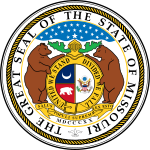Missouri, United States
| Missouri state symbols | |
|---|---|

The Flag of Missouri
|
|

The Seal of Missouri
|
|
| Living insignia | |
| Amphibian | American bullfrog |
| Bird | Eastern bluebird |
| Fish | Channel catfish |
| Flower | White hawthorn |
| Grass | Big bluestem |
| Horse breed | Missouri Fox Trotter |
| Insect | Western honey bee |
| Mammal | Missouri Mule |
| Tree | Flowering Dogwood |
| Inanimate insignia | |
| Dance | Square dance |
| Dinosaur | Hypsibema missouriensis |
| Fossil | Crinoid |
| Gemstone | Beryl |
| Mineral | Galena |
| Motto | Salus populi suprema lex esto (Latin) |
| Rock | Mozarkite |
| Soil | Menfro |
| Song | "Missouri Waltz" |
| State route marker | |
 |
|
| State quarter | |

Released in 2003
|
|
| Lists of United States state symbols | |
 |
|
|
|
Missouri is a state in the Midwestern United States. With over six million residents, it is the 18th most populous state. The largest urban areas are St. Louis, Kansas City, Springfield, and Columbia. The capitol is in Jefferson City on the Missouri River. The state is the 21st most extensive. In the South are the Ozarks, a forested highland, providing timber, minerals, and recreation. The Mississippi River forms the eastern border of the state.
Humans have inhabited the land now known as Missouri for at least 12,000 years. The Mississippian culture built cities and mounds, before declining in the 1300s. When European explorers arrived in the 1600s they encountered the Osage and Missouria nations. The French established Louisiana, a part of New France, and founded Ste. Genevieve in 1735 and St. Louis in 1764. After a brief period of Spanish rule, the United States acquired the Louisiana Purchase in 1803. Americans from the Upland South, including enslaved African Americans, rushed into the new Missouri Territory. Many from Virginia, Kentucky, and Tennessee settled in the Boonslick area of Mid-Missouri. Soon after, heavy German immigration formed the Missouri Rhineland.
...
Wikipedia



